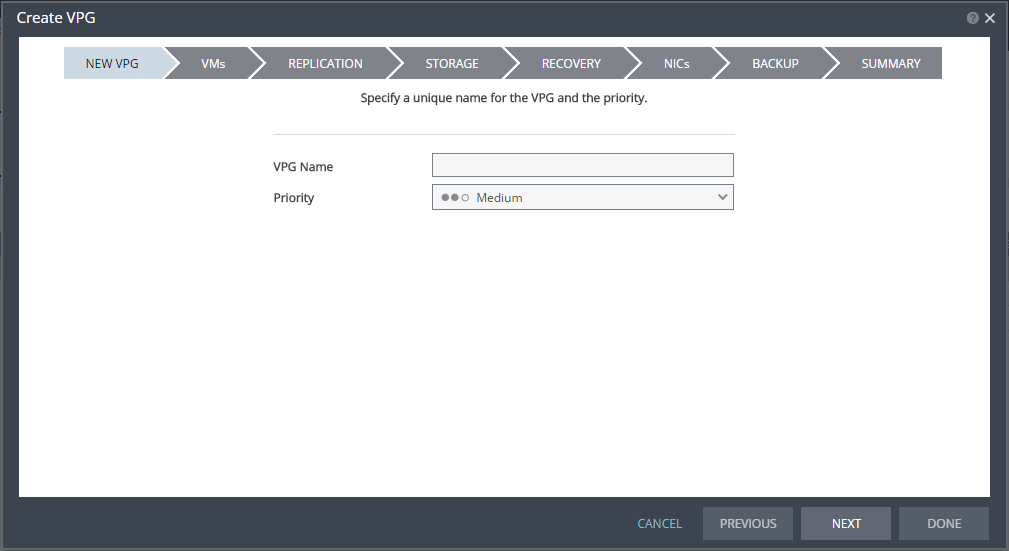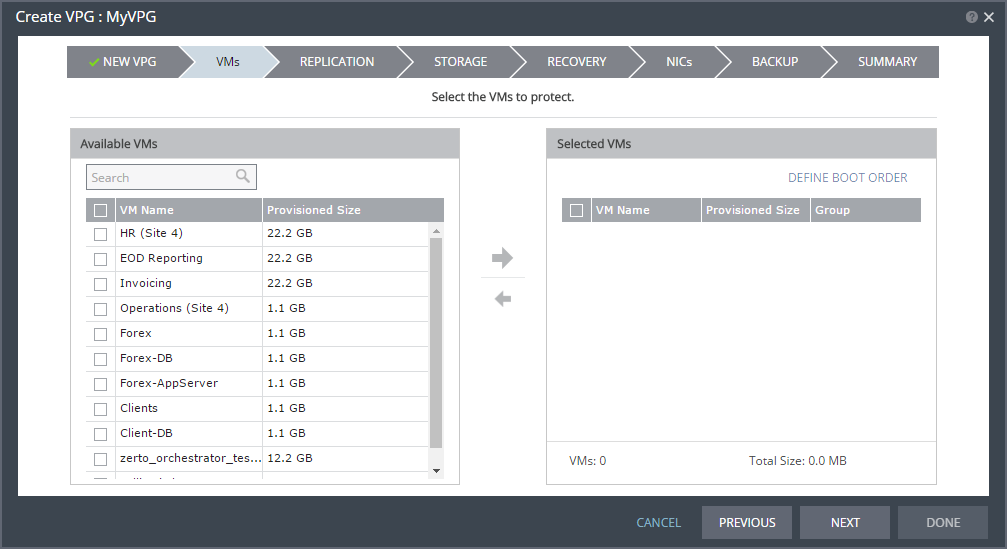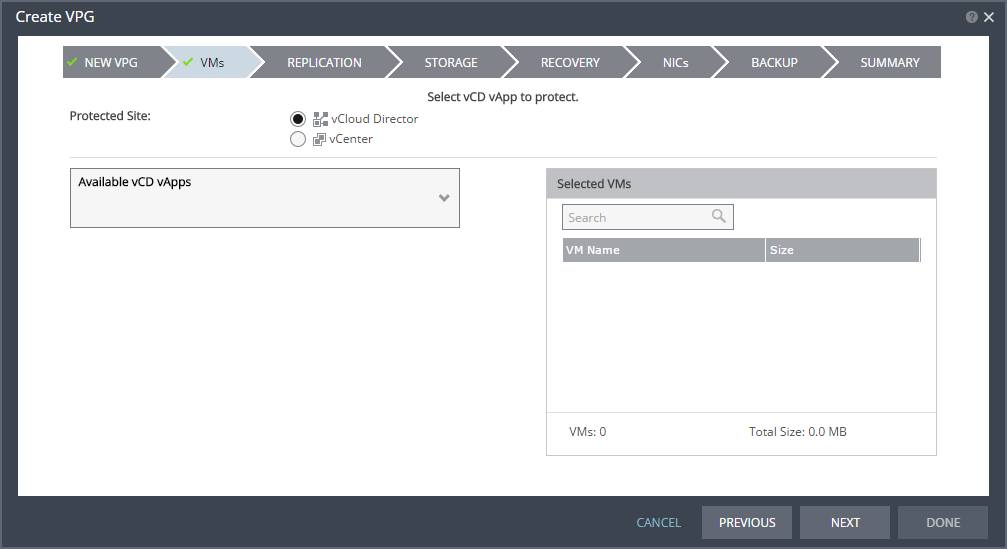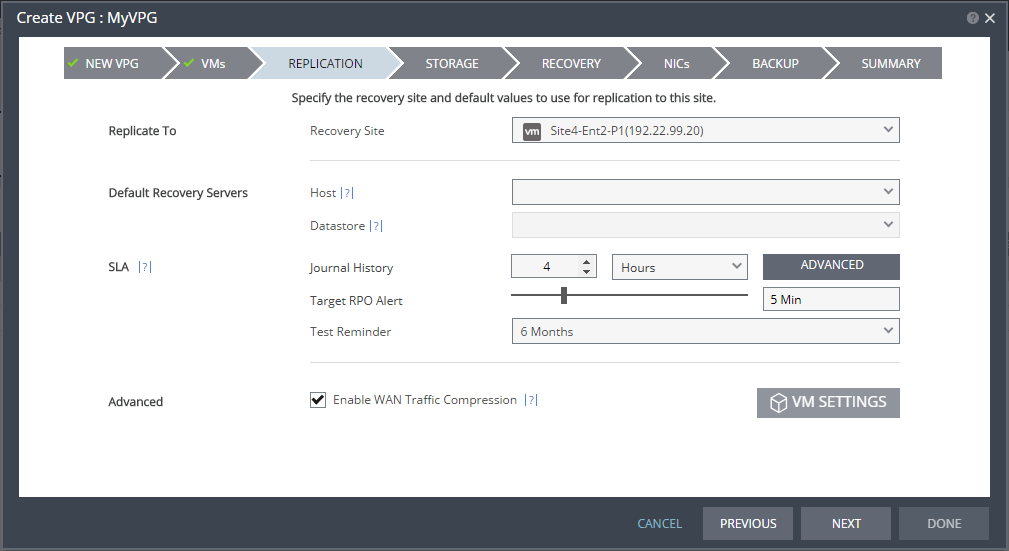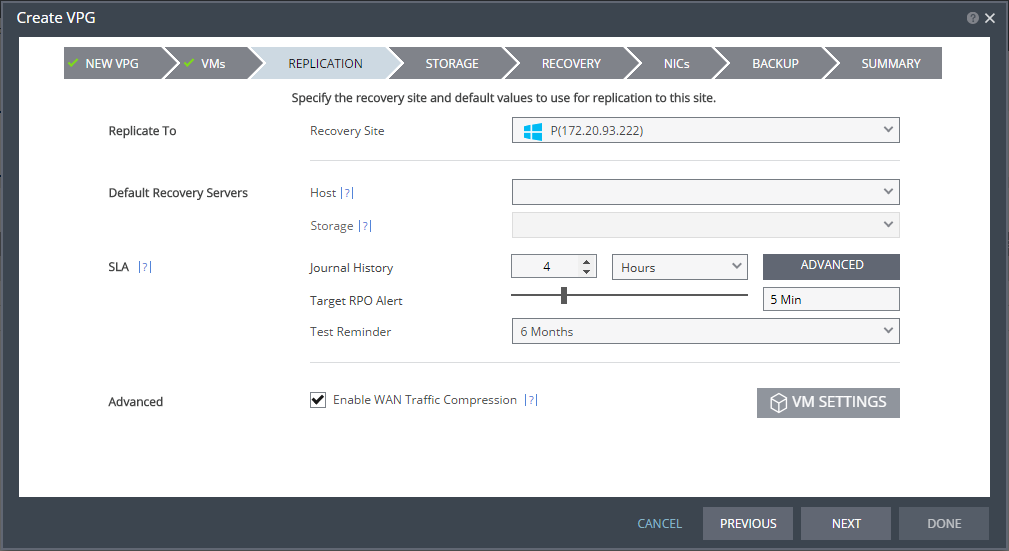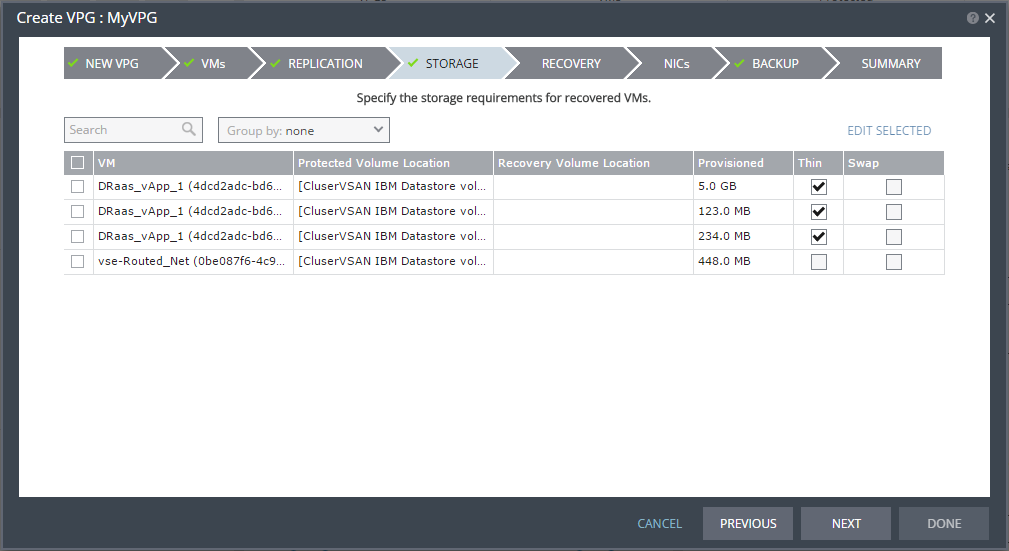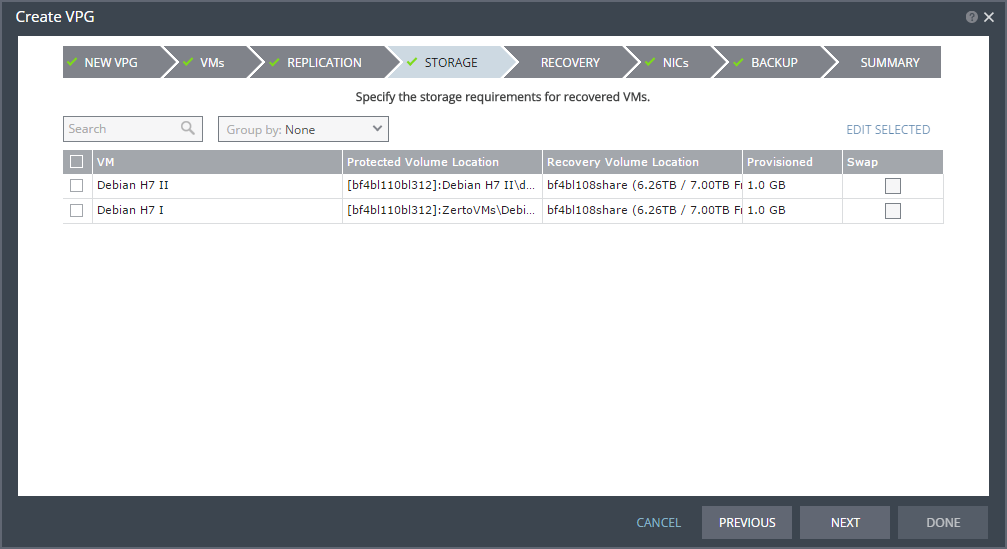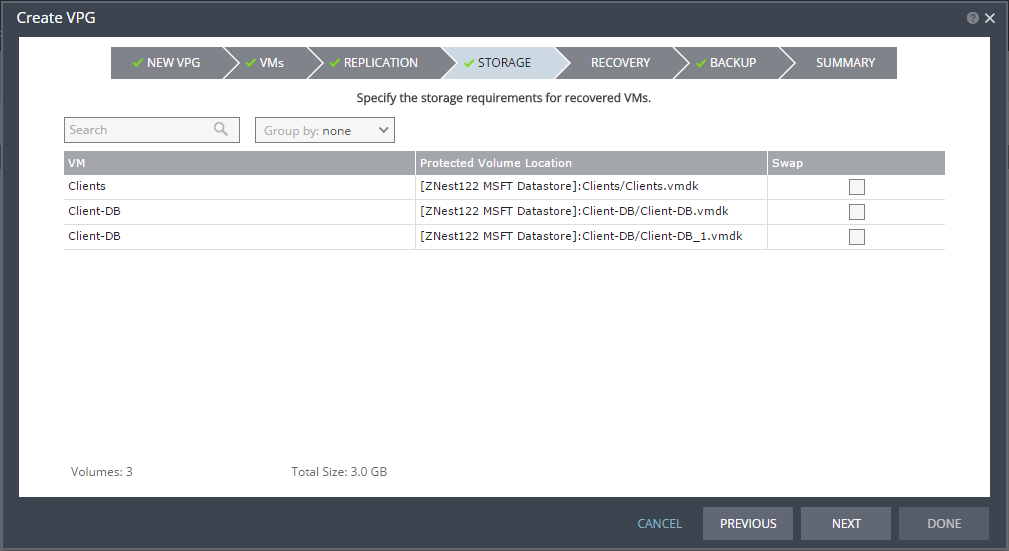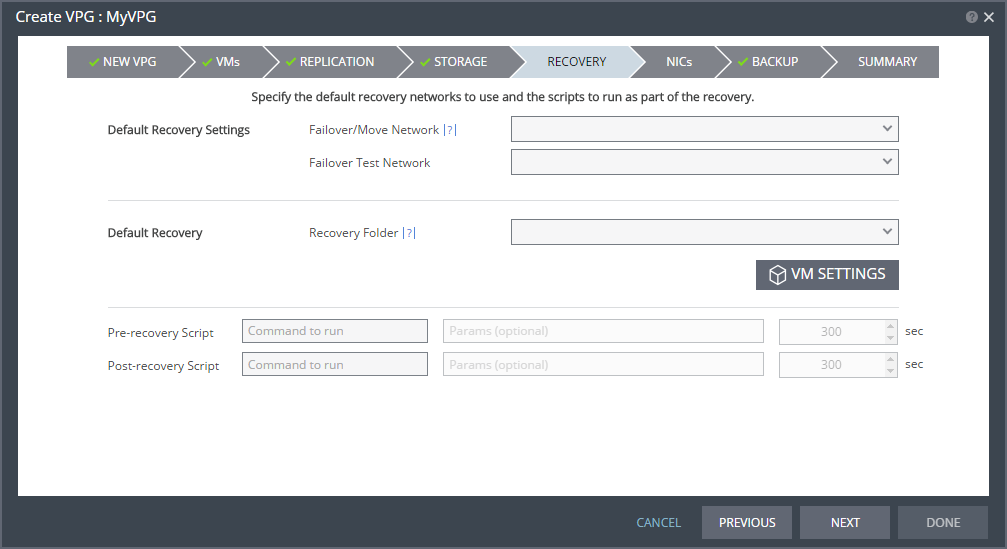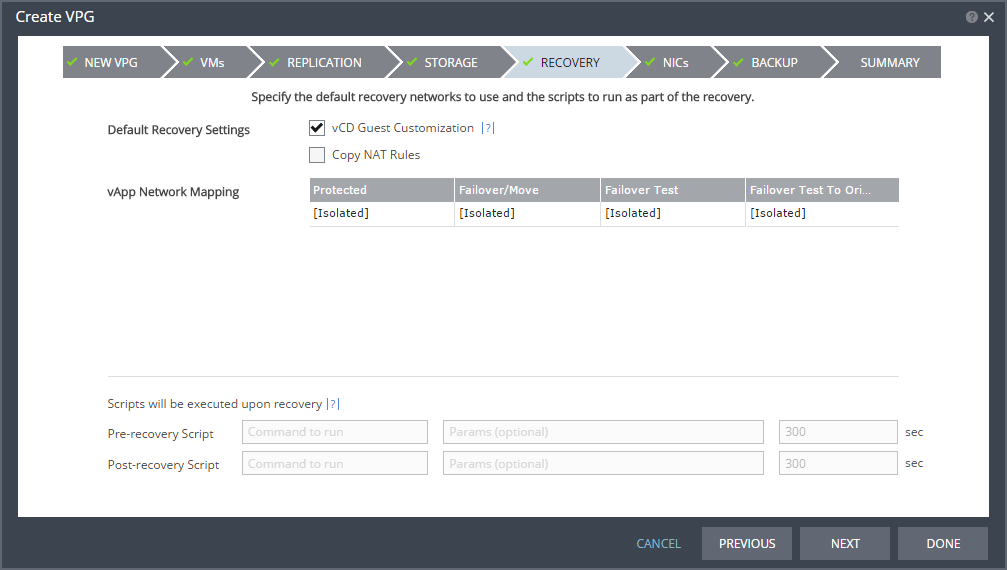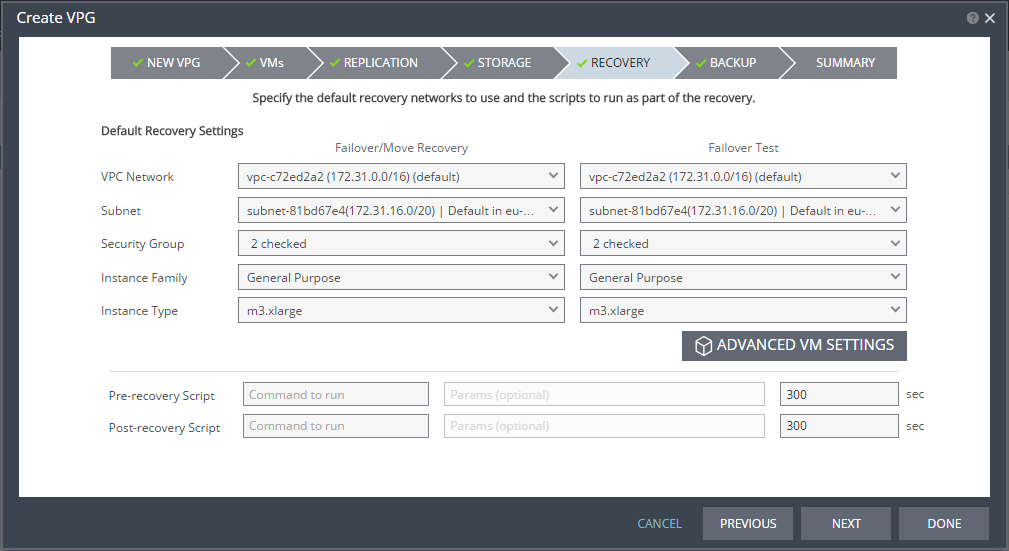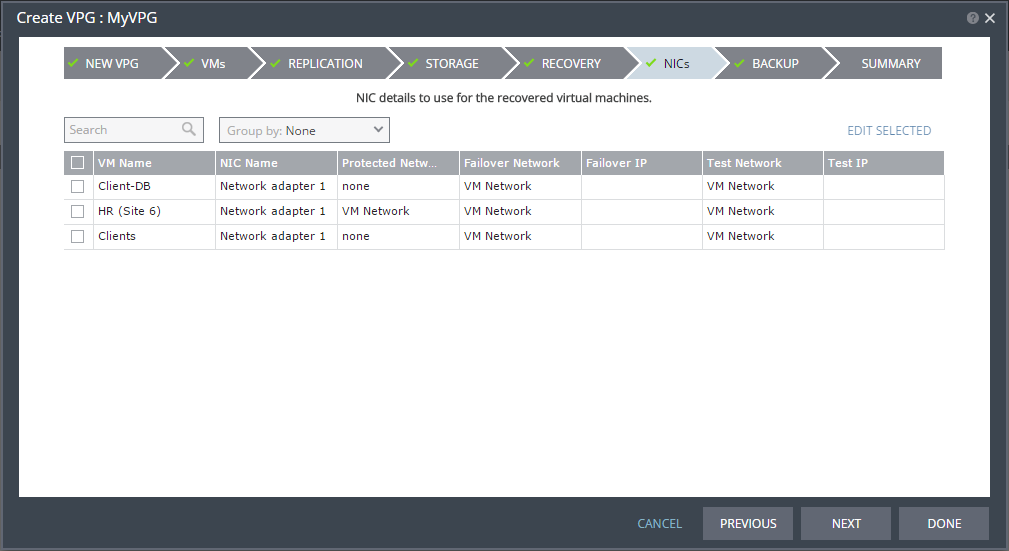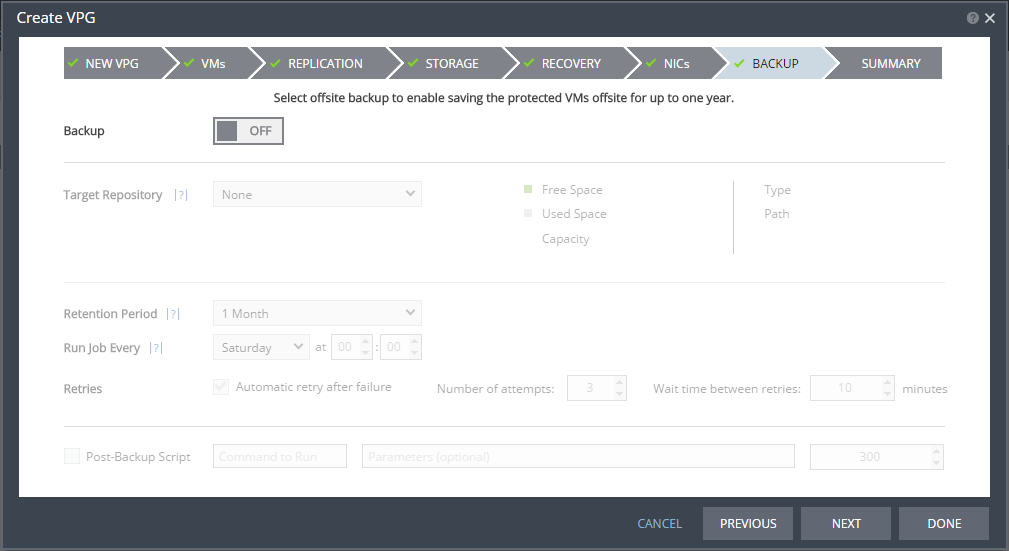The NEW VPG Step
VPG Name – The VPG name must be unique. The name cannot be more than 80 characters.
Priority – Determine the priority for transferring data from the protected site to the recovery site when there is limited bandwidth and more than one VPG is defined on the protected site. When there are updates to virtual machines protected in VPGs with different priorities, first the updates from the VPG with the highest priority are passed over the WAN. Medium priority VPGs will only be able to use whatever bandwidth is left after the high priority VPGs have used it. This is also true between medium and low priorities. Note that updates to the protected virtual machines are always sent across the WAN before synchronization data, such as during a Bitmap Sync or Delta Sync. During a synchronization, only after updates to the virtual machines are sent over the WAN, based on the VPG priority, is synchronization data from the VPG sent, and the synchronization data from the VPG with the highest priority is passed over the WAN before data from medium and low priority VPGs.
The VMs Step
This step is significantly different between VMware vCenter Server, Microsoft Hyper-V, Amazon Web Services (AWS) and VMware vCloud Director.
VMware vCenter Server, Microsoft Hyper-V and Amazon Web Services (AWS)
Select the VMs that will be part of this VPG and click the arrow pointing right to include these VMs in the VPG.
If you want to define the boot order of the virtual machines in the VPG, click DEFINE BOOT ORDER.
VMware vCloud Director
You can select virtual machines to protect either from the underlying vCenter Server or as a vCD vApp.
When a vCD vApp is selected to be protected in the VPG, the protected vCD vApp is recovered as a vCD vApp.
The REPLICATION Step
Recovery Site – The site to which you want to recover the virtual machines. After specifying the recovery site, the display changes to show only fields that are relevant for the recovery site
VMware vCenter Server recovery site:
Host – The default cluster, resource pool or host in the recovery site that handles the replicated data. If the site is defined in Zerto Cloud Manager, only a resource pool can be specified and the resource pool must also have been specified as a resource in Zerto Cloud Manager.
When a resource pool is specified, Zerto Virtual Replication checks that the resource pool capacity is enough for any virtual machines specified in the VPG.
All resource pool checks are made at the level of the VPG and do not take into account multiple VPGs using the same resource pool. If the resource pool CPU resources are specified as unlimited, the actual limit is inherited from the parent but if this inherited value is too small, failover, move, and failover test operations can fail, even without a warning alert being issued by Zerto Virtual Manager.
Note that if a resource pool is specified and DRS is disabled for the site later on, all the resource pools are removed by VMware and recovery will be to any one of the hosts in the recovery site with a VRA installed on it.
Datastore – The datastore volume to use for all recovered virtual machine files as well as for their data volumes. Every datastore for the selected recovery host is included in the drop-down list. If a cluster or resource pool is selected for the host, only datastores that are accessible by every host in the cluster or resource pool are displayed. When specifying the recovery storage for a virtual machine with a storage cluster, you must specify a datastore in the cluster.
VMware vCloud Director recovery site:
Recovery Org vDC – The recovery Org vDC to use for the recovery.
Microsoft Hyper-V recovery site:
Host – The default cluster or host, in the recovery site that handles the replicated data.
Storage – The storage volume to use for all the recovered virtual machine files as well as for their data volumes. Every storage for the recovery host is included in the drop-down list. If a cluster is selected for the host, only storage accessible by every host in the cluster are displayed. When specifying the recovery storage for a virtual machine with a storage cluster, you have to specify storage in the cluster.
Journal History – The time for which all write commands are saved in the journal. The longer the information is saved in the journal, the more space is required for each journal in the VPG. You can select the number of hours from 1 to 24 or the number of days from 2 to 14. For additional journal-related fields (VMware vCenter Server and Microsoft Hyper-V), click ADVANCED.
Note: Amazon Web Services (AWS) recovery site: Advanced journal configuration is not available.
Target RPO Alert - The maximum desired time between each automatic checkpoint write to the journal before an alert is issued. To increase the value, move the slider right; to decrease the value, move the slider left.
Test Reminder - The time recommended between testing the integrity of the VPG. A warning is issued if a test is not done within this time frame.
Enable WAN Traffic Compression – Whether or not data is compressed before being transferred to the recovery site. Compressing the data is more efficient but results in a small performance degradation. Enable WAN traffic compression if network considerations are more critical than CPU usage considerations. Even if WAN compression is selected, Zerto Virtual Replication decreases the level of compression if it takes too many resources. The VRA automatically adjusts the compression level according to CPU usage, including totally disabling it if needed. Zerto Virtual Replication can also work with third-party WAN optimization and acceleration technologies, such as those supplied by Riverbed Technologies and Silver Peak. When third-party WAN optimization is implemented, Zerto recommends disabling VPG WAN compression.
The STORAGE Step
By default the storage used for the virtual machine definition is also used for the virtual machine data. For each virtual machine in the VPG, Zerto Virtual Replication displays its storage-related information.
VMware vCenter Server recovery site:
Thin provisioning – If the recovery volumes are thin-provisioned or not.
Microsoft Hyper-V recovery site:
AWS recovery site:
Swap – If the virtual machine to be replicated includes a swap disk as part of its configuration, mark the recovery disk for this disk as a swap disk. In this case, data is not replicated to the swap disk after initial synchronization.
Steps that have been completed are marked with a check mark. You can jump directly to a step that has been marked with a check mark to edit the values for that step. Every step must be marked with a check mark before you can click DONE to create the VPG.
VMware vCenter Server and Microsoft Hyper-V only: If you want to edit storage information for one of the virtual machines, select the machine and click EDIT SELECTED.
The RECOVERY Step
This step is significantly different for VMware vCenter Server, VMware vCloud Director and Microsoft Hyper-V, and Amazon Web Services (AWS).
VMware vCenter Server and Microsoft Hyper-V
Recovery details include the networks to use for failover, move, and for testing failover, and whether scripts should run as part of the recovery operation.
Failover/Move Network – The network to use during a failover or move operation in which the recovered virtual machines will run.
Failover Test Network – The network to use when testing the failover of virtual machines in the recovery site. Zerto recommends using a fenced-out network so as not to impact the production network at this site.
Recovery Folder (VMware vCenter Server only) – The folder to which the virtual machines are recovered. To specify a recovery folder for each virtual machine in the VPG, click VM SETTINGS.
Check the Scripts box if scripts should run as part of the recovery process.
Pre-recovery Script – The information about a script that should run at the beginning of the recovery process.
Post-recovery Script – The information about a script that should run at the end of the recovery process.
For both types of scripts, enter the following information:
Field | Description |
Command to run | The full path of the script. The script must be located on the same machine as the Zerto Virtual Manager for the recovery site. |
Params | The parameters to pass to the script. Separate parameters with a space. |
Timeout | The time-out, in seconds, for the script to run. If the script runs before executing a failover, move, or test failover, and the script fails or the timeout value is reached, an alert is generated and the failover, move, or test failover is not performed. If the script runs after executing a failover, move, or test failover, and the timeout value is reached, an alert is generated. The default time-out value is specified in Performance and Throttling tab in the Site Settings dialog. |
VMware vCloud Director
Recovery details include the networks to use for failover, move, and for testing failover, and whether scripts should run as part of the recovery operation.
vCD Guest Customization – When checked, VMware Guest OS Customization is enabled for the virtual machine in vCloud Director. Enabling guest customization means that the computer name and network settings configured for this virtual machine are applied to its Guest OS when the virtual machine is powered on.
Copy NAT Rules– When checked, NAT rules for a NAT Router Org network are applied during recovery. The automatic setting is applied as automatic and the manual setting is applied as manual using the IPs on the source.
vApp Network Mapping – The networks to use for failover and move operations, for failover test operations, and for test failover operations after a failover or move when reverse protection is configured. The list of current Org Networks is displayed and you can specify what network to use in each of the situations. <Isolated> means that the network is an internal only vApp network.
Check the Scripts box if scripts should run as part of the recovery process.
Pre-recovery Script – The information about a script that should run at the beginning of the recovery process.
Post-recovery Script – The information about a script that should run at the end of the recovery process.
For both types of scripts, enter the following information:
Field | Description |
Command to run | The full path of the script. The script must be located on the same machine as the Zerto Virtual Manager for the recovery site. |
Params | The parameters to pass to the script. Separate parameters with a space. |
Timeout | The time-out, in seconds, for the script to run. If the script runs before executing a failover, move, or test failover, and the script fails or the timeout value is reached, an alert is generated and the failover, move, or test failover is not performed. If the script runs after executing a failover, move, or test failover, and the timeout value is reached, an alert is generated. The default time-out value is specified in Performance and Throttling tab in the Site Settings dialog. |
Amazon Web Services (AWS)
Recovery details include the networks to use for failover, move, and testing failover, and whether scripts should run as part of the recovery process.
Steps that have been completed are marked with a check mark. You can jump directly to a step that has been marked with a check mark to edit the values for that step. Every step must be marked with a check mark before you can click DONE to create the VPG.
VPC Network - The virtual network dedicated to your AWS account.
Subnet - The subnet mask for the VPC network.
Security Group - The AWS security to be associated with the virtual machines in this VPG.
Select these recovery settings for both failover/move and failover testing.
Check the Scripts box if scripts should run as part of the recovery process.
Pre-recovery Script – The information about a script that should run at the beginning of the recovery process.
Post-recovery Script – The information about a script that should run at the end of the recovery process.
For both types of scripts, enter the following information:
Field | Description |
Command to run | The full path of the script. The script must be located on the same machine as the Zerto Virtual Manager for the recovery site. |
Params | The parameters to pass to the script. Separate parameters with a space. |
Timeout | The time-out, in seconds, for the script to run. If the script runs before executing a failover, move, or test failover, and the script fails or the timeout value is reached, an alert is generated and the failover, move, or test failover is not performed. If the script runs after executing a failover, move, or test failover, and the timeout value is reached, an alert is generated. The default time-out value is specified in Performance and Throttling tab in the Site Settings dialog. |
The NICs Step
VMware vCenter Server and Microsoft Hyper-V only.
You can specify the NIC details to use for the recovered virtual machines after a failover, a test failover, or migration.
If you want to edit NIC-related information for one or more of the virtual machines, select the machines and click EDIT SELECTED.
The BACKUP Step
Backup properties govern the VPG backup, including the repository where the backups are saved. Backup extends the ability to recover virtual machines in a VPG going back one year.
By default, backup is off. Toggle OFF to ON to enter offsite backup information.
Target Repository – The name of the repository where the offsite backups are written. Repositories are configured via the SETUP tab as described.
Retention Period – The length of time to keep offsite backups, up to a maximum of one year.
Run Job Every – The day and time to start the backup.
Retries – Whether to rerun the backup job automatically if the job fails. If you select this option, you must also define the number of retries that will be attempted and the time to wait after a job fails before running the backup job again.
Post-Backup Script - The information about a script that should run at the end of the recovery process. Enter the following information:
Field | Description |
Command to run | The full path of the script. The script must be located on the same machine as the Zerto Virtual Manager for the recovery site. |
Params | The values of parameters to pass to the script. Separate parameters with a space. |
Timeout | The time-out, in seconds, for the script to run. If the timeout value is reached, an alert is generated. The default time-out value is specified in the Performance and Throttling tab of the Site Settings dialog. |
The SUMMARY Step
Shows the VPG configuration that you defined in previous tabs.
